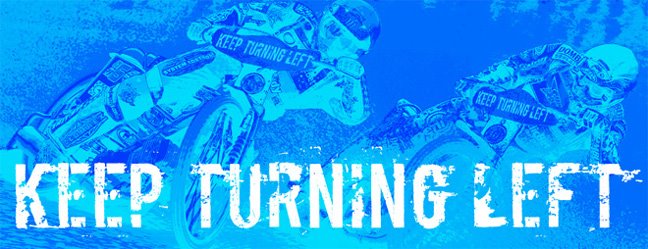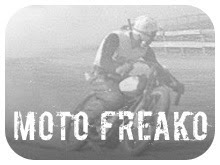Review of Jeff Scott's Shale Trek by Gary Pinchin of Motorcycle News.
It’s speedway – but not as we know it:
Speedway. First out of the gate wins. God, I hate that cliché.
It’s true you don’t get much overtaking when you set four, brakeless, methanol-burning 500cc race bikes off around a 350 metre oval dirt track, but when someone does manage it you just want to punch the air and scream yyyyyesssss with excitement – and then ramble on for days to who ever will listen how that one overtake you saw was worth the admission price alone.
Yeah, I’ve got a passing interest in speedway (I’m not apologising for the pun) and, as a fan, I know you have to cling on to those special moments – as much as football fans cling to England success.
I love speedway’s grass roots, earthy, organic feel that once was the preserve of the working man – and maybe still is.
But I’ve always thought of it as an awesome sport promoted badly by well-intentioned used car dealers and scrap metal merchants for highly professional racers who put on an incredible show of gladiatorial warfare that so few people get to see.
Phew, got that one off my chest.
Don’t take that wrong. That’s a positive for me! The tired, backwater stadia have a lovely grungy appeal, harking back to the early Seventies when I first ventured to Blunsdon Road to see Martin Ashby and Bob Kilby starring for the Swindon Robins.
Speedway, at it’s best, is as good as any professional motorsport you’ll see anywhere in the world but it’s full of foibles and weird rules that can make the sport a laughing stock – even to it’s own band of followers.
And that is the vibe you get from reading Jeff Scott’s latest heavyweight tome ‘Shale Trek.’ Here’s a fan who clearly loves his sport but isn’t afraid to talk about it’s shortcomings.
And, as it says on the tin (well, back cover), Scotty does indeed boldly go where other speedway writers dare to tread.
His books – yes, this is his eighth in what he describes as a ‘trilogy gone terribly wrong’ on the state of British speedway in the 21st century – tell it like it is and certainly take me right back to the terraces and the heady aroma of methanol fuel, Castrol R, and eyes full of shale dust.
This is another personal tour of the UK speedway tracks, this time to promote his earlier “Quantum of Shale” and is so refreshing in it’s honesty in a world where most motorsport is homogenised by political correctness.
When I first saw one of his books I laughed at the outrageous volume of words he can bang out on one two-hour race meeting but once I got hooked into it, I laughed at the anecdotes of the track staff who describe their own meeting as crap, at Scott’s experiences of the Talke Travelodge near Stoke Speedway (not that the state of his room had anything to do with speedway) and the sport’s rules – which seems to be an ongoing debate among all speedway fans if this book is any guide.
Oh how I chuckled as I read his condemnation of the sport’s rules that often require university degree to fathom.
“Speedway rule changes and general strangeness have always gone together….,” he says.
And then we get the full explanation, during his Buxton Speedway chapter, going back to 1929 of how the rules have evolved and how bits of the old rule books have crept into current rulebook.
It’s a great, if rambling history lesson… and even more complicated than this year’s BSB point-scoring structure!
The 2001 rulebook apparently demanded, if the mechanical start gate failed, you had to use a piece of elastic to start the races.
Fair enough I thought, but Scott* takes great delight in pointing out Belle Vue – only a week earlier on his travels in 2009 – couldn’t find a piece of elastic in the entire stadium when their gate failed.
But instead of letting us in on the solution, Scott suddenly turns his attention to wanting to know the difference between stock cars and drift cars. Eclectic? You bet.
Scott’s style is unique and if you want an entertaining read that’s also loosely connected with motorcycle sport then it’s well worth the £20.
And if you’ve even a vague interest in speedway, I’ll guarantee you’ll be checking out the fixtures list of your local team to catch up on the action. I certainly have!
by Gary Pinchin, Motorcycle News.
Shale Trek is available to buy from Methanol Press.
Photos by Jeff Scott. If you like these charming photos, be sure to check out Jeff's photo book Shale Britannia.






































































